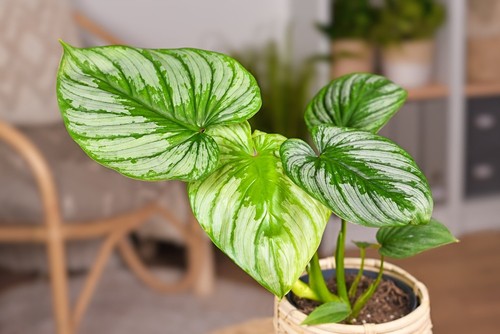Philodendrons are popular houseplants known for their attractive foliage and easy care. However, yellow leaves and brown spots on philodendrons are common problems that can affect their appearance and health.
These issues can be caused by a variety of factors, including environmental stress, pests, diseases, and improper care.
Understanding the causes of yellow leaves and brown spots on philodendrons is essential for their proper care and maintenance. Environmental factors such as low humidity, temperature stress, and too much direct sunlight can cause yellowing and browning of leaves in philodendrons.
Overwatering or underwatering can also lead to these problems, as well as nutrient deficiencies or excesses. Pests like spider mites and mealybugs can cause damage to the leaves, while diseases like leaf spot and root rot can lead to yellowing and browning.
Key Takeaways on Philodendron Leaves Turning Yellow with Brown Spots
- Yellow leaves and brown spots on philodendrons can be caused by a variety of factors, including environmental stress, pests, diseases, and improper care.
- Proper watering, lighting, and fertilization are essential for preventing yellow leaves and brown spots on philodendrons.
- Regular inspection and treatment for pests and diseases can help maintain the health and appearance of philodendrons.
Check out these other related posts:
- Why Does My Rubber Plant Have Brown Spots?
- Pepper Plant Leaves Turning Yellow with Brown Spots
- Peach Tree Leaves Turning Yellow with Brown Spots
Understanding Philodendron Diseases
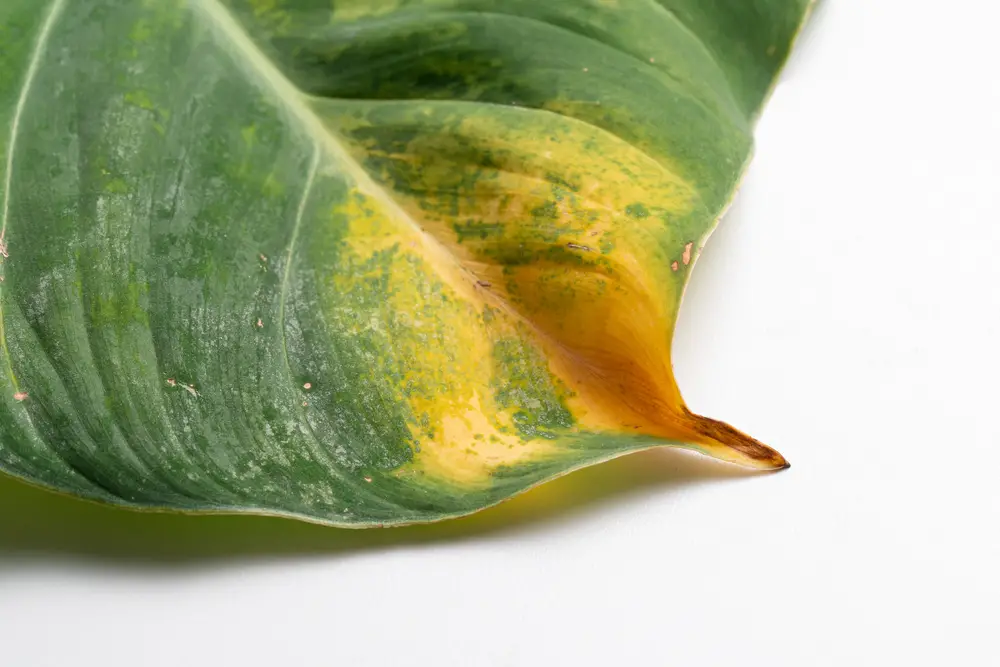
Philodendrons are popular houseplants known for their lush foliage and easy care requirements. However, like all plants, they are susceptible to diseases that can cause yellow leaves and brown spots. Understanding the common diseases that affect philodendrons can help prevent and treat these issues.
Identifying Leaf Spot Disease
Leaf spot disease is a common problem that affects many types of plants, including philodendrons. This fungal disease is characterized by small, circular spots on the leaves that can be yellow, brown, or black in color. The spots may also have a yellow halo around them.
Fungal leaf spot is caused by a fungus that thrives in warm, humid conditions. It can spread quickly and cause significant damage to the plant if left untreated.
To prevent fungal leaf spot, it is important to avoid overwatering and to provide good air circulation around the plant. If leaf spot is identified, affected leaves should be removed and destroyed to prevent the spread of the fungus.
Recognizing Root Rot
Root rot is another common problem that can cause yellow leaves and brown spots on philodendrons. This bacterial disease is caused by overwatering or poor drainage, which leads to the roots becoming waterlogged and unable to absorb nutrients properly.
Symptoms of root rot include yellow leaves, wilting, and a foul odor coming from the soil. To prevent root rot, it is important to ensure that the philodendron is planted in well-draining soil and that the plant is not overwatered. If root rot is identified, affected roots should be pruned and the plant should be repotted in fresh soil.
By understanding the common diseases that affect philodendrons, such as leaf spot and root rot, plant owners can take steps to prevent and treat these issues. Regularly monitoring the plant’s health and providing proper care can help keep philodendrons healthy and thriving.
Environmental Factors Affecting Philodendron Health
Philodendrons are tropical plants that require specific environmental conditions to thrive. Several factors can affect the health of the plant, including light conditions, temperature, humidity, and air circulation. Understanding these factors is crucial to maintain the health of your philodendron.
1. Importance of Light Conditions
Light is one of the most important factors that affect philodendron health. These plants prefer bright, indirect light and can tolerate low light conditions. Direct sunlight can cause sunburn and damage the leaves, so it’s important to avoid exposing the plant to direct sunlight for extended periods.
In low light conditions, philodendrons may grow slower and produce smaller leaves. If the plant is not getting enough light, it may also become leggy, with long stems and sparse foliage. Providing adequate light is essential to maintain the plant’s health and promote healthy growth.
2. Role of Temperature

Philodendrons prefer warm temperatures between 65-80°F (18-27°C). Temperatures below 55°F (13°C) can cause the plant’s growth to slow down, and prolonged exposure to low temperatures can damage the leaves and cause them to turn brown or yellow.
On the other hand, temperatures above 90°F (32°C) can cause the plant to wilt and droop. It’s important to keep the plant away from cold drafts and air conditioning vents, which can cause temperature fluctuations and affect the plant’s health.
3. Humidity and Air Circulation Requirements
Philodendrons require high humidity levels to thrive. Low humidity can cause the leaves to turn brown and crispy, while high humidity can promote fungal growth and attract pests. It’s recommended to keep the humidity levels between 50-60% for optimal plant health.
Air circulation is also important for philodendrons, as it helps prevent fungal growth and pest infestations. Stagnant air can cause the plant to become susceptible to diseases and pests. It’s recommended to provide adequate air circulation by using a fan or opening windows to maintain the health of your philodendron.
Watering and Its Impact on Philodendron Leaves
Proper Watering Techniques
Proper watering techniques are critical to maintaining healthy philodendron leaves. Overwatering or underwatering can lead to yellow leaves, brown spots, and other watering problems. The general rule of thumb is to water philodendrons when the top inch of soil feels dry to the touch.
When watering, it’s important to water thoroughly so that the water reaches the roots. However, it’s equally important to ensure that the soil is not left soggy. Soggy roots can lead to root rot, which can be fatal to the plant. To prevent this, make sure that the pot has drainage holes to allow excess water to escape.
Understanding Soil Moisture and Drainage
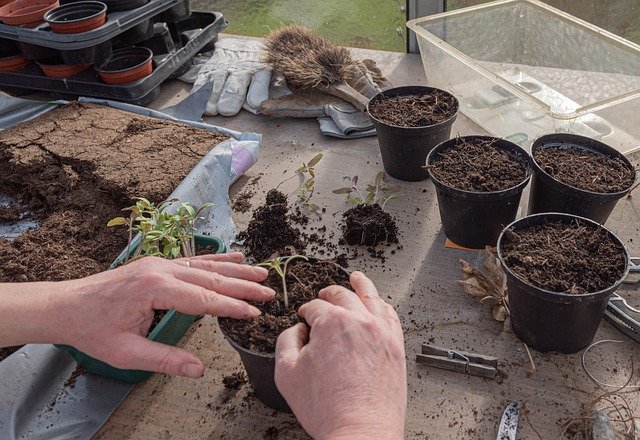
Understanding soil moisture and drainage is also crucial to maintaining healthy philodendron leaves. Philodendrons prefer well-draining soil that retains moisture but doesn’t become waterlogged. The soil should be a mix of peat moss, perlite, and vermiculite.
To test the moisture level of the soil, simply insert your finger into the top 1 to 2 inches. If it feels moist, wait a few more days and then test the soil again, making sure to only water when it feels dry. If the plant has been underwatered for some time, it will begin to experience wilting, and your philodendron’s growth rate will slow.
Water quality can also impact the health of philodendron leaves. Tap water may contain minerals that can build up in the soil over time, leading to watering problems.
Rainwater is an excellent alternative for watering philodendrons, as it is free of minerals and other chemicals. However, if rainwater is not available, distilled water can also be used.
Philodendron Nutrient Needs and Deficiencies
Essential Nutrients for Philodendrons
Like all plants, philodendrons require certain essential nutrients to grow and thrive. These nutrients include nitrogen, phosphorus, potassium, calcium, magnesium, and sulfur. Nitrogen is essential for leaf growth and overall plant health, while phosphorus is important for root development and flower production.
Potassium helps regulate water balance and aids in disease resistance, while calcium strengthens cell walls and helps prevent blossom end rot. Magnesium is necessary for photosynthesis and chlorophyll production, and sulfur is important for protein synthesis.
Philodendrons obtain these essential nutrients from the soil, but it is important to ensure that the soil is properly fertilized to provide an adequate supply. Organic matter, such as compost or aged manure, can also help improve soil fertility and provide additional nutrients.
Recognizing and Treating Nutrient Deficiencies
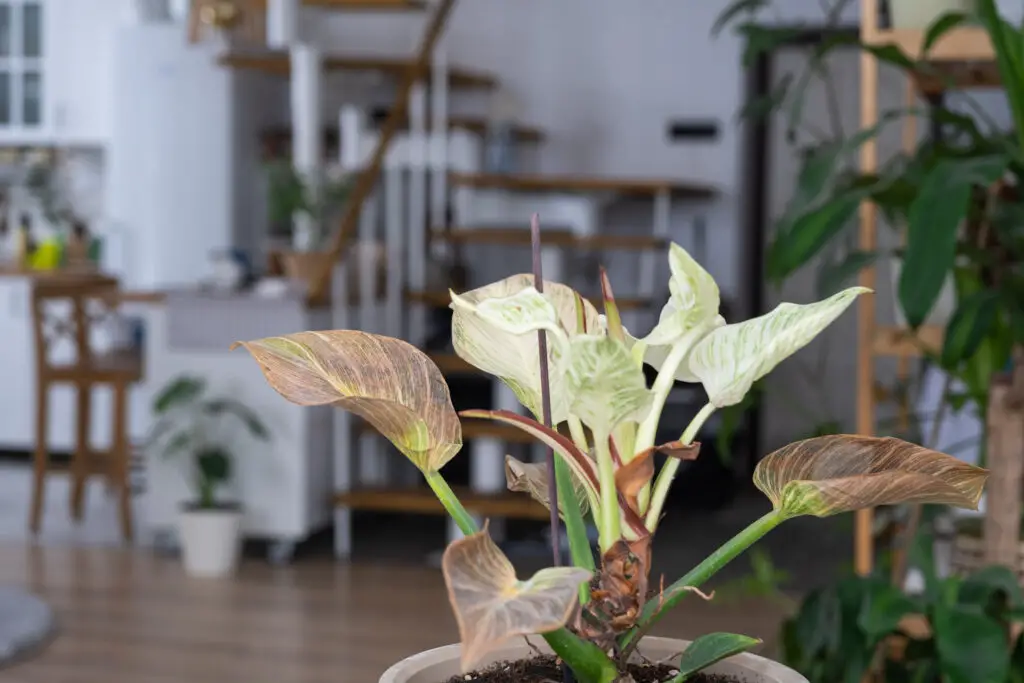
When philodendrons do not receive enough of one or more essential nutrients, they can develop nutrient deficiencies. Common nutrient deficiencies in philodendrons include nitrogen and magnesium deficiencies.
Nitrogen deficiency can cause yellowing of older leaves, while magnesium deficiency can cause yellowing and brown spots on leaves.
To treat nutrient deficiencies, it is important to identify which nutrient is lacking and provide the plant with the appropriate fertilizer. For nitrogen deficiency, a fertilizer with a high nitrogen content can be applied.
For magnesium deficiency, a fertilizer with a high magnesium content can be used. In some cases, foliar sprays may be necessary to correct the deficiency more quickly.
It is important to note that over-fertilization can also cause problems, so it is important to follow the recommended dosage and frequency when fertilizing philodendrons. Additionally, it is important to ensure that the soil is well-draining to prevent nutrient imbalances and root rot.
Philodendron Pests and Infestation
Common Philodendron Pests
Philodendrons are relatively easy to care for, but they are still susceptible to pests and infestations. Here are some common pests that can affect philodendrons:
- Aphids: These are small sap-sucking insects that can cause yellowing of the leaves and distortion of the plant. They usually attack new growths on the plant and can be green, yellow, light brown, red, or light green in color.
- Spider Mites: These are tiny insects that can cause yellowing of the leaves and the formation of webs on the plant. They are common in dry environments and can be difficult to get rid of.
- Mealybugs: These are small white insects that can cause yellowing of the leaves and a sticky residue on the plant. They are usually found in the crevices of the plant and can be difficult to get rid of.
Preventing and Treating Infestations
Preventing and treating infestations is essential to keep your philodendron healthy. Here are some tips to prevent and treat infestations:
- Inspect your plant: Regularly inspect your plant for signs of infestation. Look for yellowing of the leaves, distortion of the plant, and the presence of insects.
- Isolate the plant: If you notice any signs of infestation, isolate the plant to prevent the infestation from spreading to other plants.
- Remove the affected leaves: If you notice any yellowing or distorted leaves, remove them immediately to prevent the infestation from spreading.
- Use insecticides: Use insecticides to get rid of the pests. Be sure to follow the instructions carefully and choose an insecticide that is safe for your plant.
- Use natural remedies: You can also use natural remedies to get rid of pests. For example, you can use neem oil, soap spray, or alcohol spray to get rid of aphids and mealybugs.
Philodendron Care and Maintenance
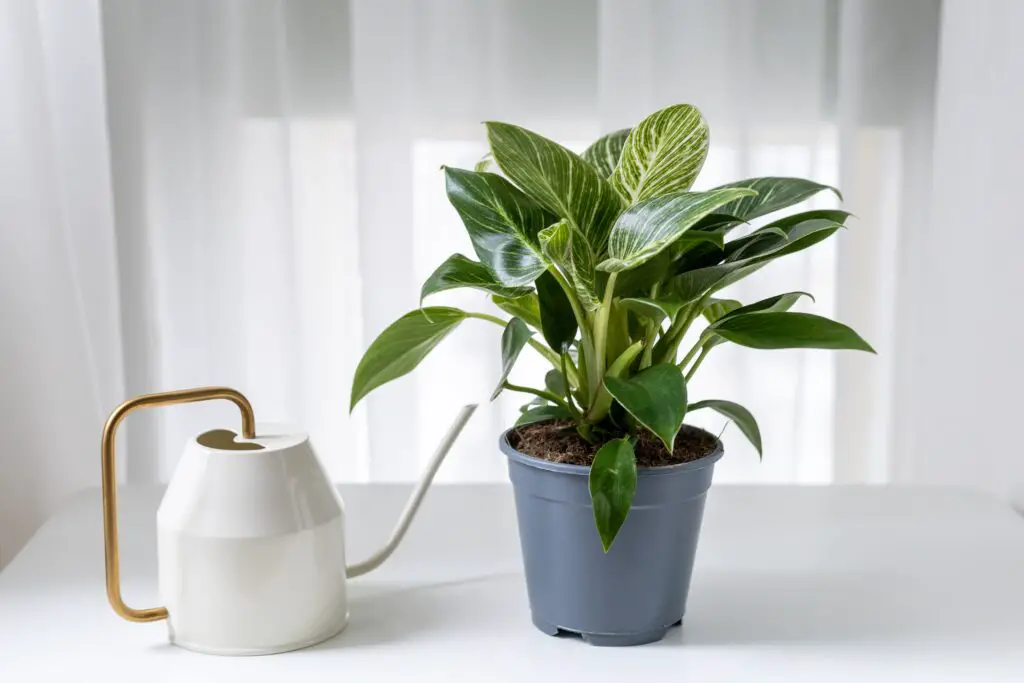
Philodendrons are beautiful houseplants that are easy to care for and maintain. Proper care and maintenance can help prevent brown spots and yellow leaves on the plant. This section will cover the ideal growing conditions, repotting, and maintenance tips for philodendrons.
1. Ideal Growing Conditions
Philodendrons are tropical plants that thrive in medium to low light settings. They prefer temperatures between 60 and 75 degrees Fahrenheit and high humidity. When exposed to direct sunlight, the leaves can develop brown spots or yellowing.
The plant should be watered when the top inch of soil is dry. Overwatering can lead to root rot, while underwatering can cause the leaves to turn yellow. The plant should also be fertilized every two weeks during the growing season with a balanced fertilizer.
2. Repotting
Philodendrons should be repotted every two to three years or when the plant outgrows its container. When repotting, it is essential to use a well-draining soil mix and a container with drainage holes to prevent water from accumulating in the soil.
To repot the plant, gently remove it from its current container and loosen the roots. Place the plant in the new container and add soil around the roots. Water the plant thoroughly after repotting.
3. Maintenance Tips
To maintain a healthy philodendron, it is essential to provide it with proper care. The plant should be checked regularly for signs of pests or diseases, such as brown spots or yellow leaves. Any affected leaves should be removed immediately to prevent the spread of disease.
Philodendrons can also benefit from occasional pruning to promote new growth and maintain their shape. When pruning, it is important to use clean, sharp scissors or pruning shears to prevent damage to the plant.
Improper care and maintenance can lead to brown spots and yellow leaves on philodendrons. By providing the plant with ideal growing conditions, repotting when necessary, and maintaining it properly, the plant can thrive and remain healthy.
Common Leaf Problems in Philodendrons
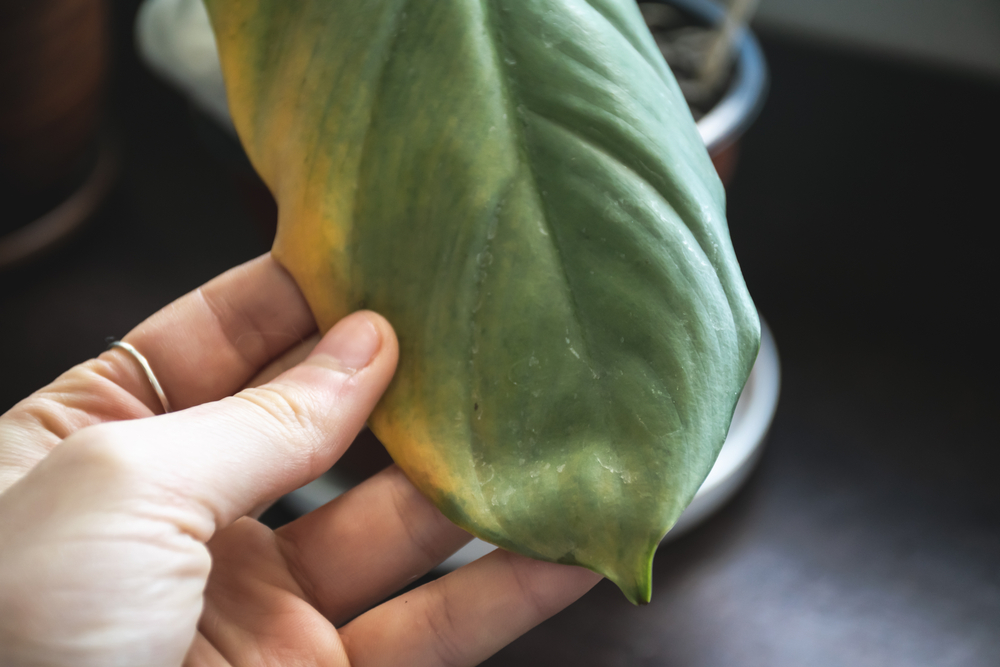
Understanding Leaf Discoloration
Philodendrons are generally easy to care for, but they can still experience a range of problems, including leaf discoloration. One of the most common issues is when the leaves turn yellow, brown, or develop yellow halos.
This can be caused by a variety of factors, including overwatering, underwatering, poor light conditions, nutrient deficiencies, pest infestations, or fungal diseases.
Yellowing leaves are often a sign of chlorosis, which is a condition where the plant is not getting enough nutrients, particularly iron. Brown edges or brown spots on the leaves can be caused by too much sun or too little water. Wilting and falling leaves can also be a sign of overwatering or underwatering, as well as root rot.
Dealing with Wilting and Falling Leaves
If the philodendron’s leaves are wilting or falling off, it’s important to identify the underlying cause. Overwatering is a common cause of wilting and falling leaves, as it can lead to root rot. To prevent this, make sure the soil is well-draining and allow the soil to dry out between waterings.
Underwatering can also cause leaves to wilt and fall off. In this case, make sure the plant is getting enough water and that the soil is moist but not waterlogged. If the plant is in direct sunlight, move it to a shadier spot as too much sun can cause leaves to wilt and dry out.
If the philodendron is suffering from root rot, it’s important to remove the affected roots and repot the plant in fresh soil. It may also be necessary to treat the plant with a fungicide to prevent the spread of the disease.
Treatment and Prevention of Philodendron Diseases
Treating Infected Philodendrons
If your philodendron is already infected with a disease, it’s important to take quick action to treat it. The first step is to identify the specific disease affecting your plant, as different diseases require different treatments. Common diseases that affect philodendrons include bacterial leaf spot, fungal leaf spot, and root rot.
For bacterial and fungal leaf spots, it’s important to remove any infected leaves immediately and dispose of them in the trash. You can also apply a fungicide to the remaining leaves to prevent further spread of the disease.
For root rot, it’s important to repot the plant in fresh, well-draining potting medium and reduce watering frequency.
It’s also important to ensure that your infected philodendron is receiving optimal conditions for photosynthesis. This includes providing bright indirect light and avoiding over-fertilization, which can stress the plant and make it more susceptible to disease.
Preventive Measures for Philodendron Diseases
Preventing philodendron diseases is key to keeping your plant healthy and thriving. Here are some preventive measures you can take:
- Use a well-draining potting medium to prevent waterlogging and root rot.
- Avoid over-watering your philodendron, as this can lead to fungal and bacterial growth.
- Provide bright indirect light to promote healthy growth and photosynthesis.
- Avoid over-fertilizing your plant, as this can stress the plant and make it more susceptible to disease.
- Regularly inspect your plant for signs of disease, such as yellow leaves and brown spots, and take quick action to treat any infections.
Frequently Asked Questions
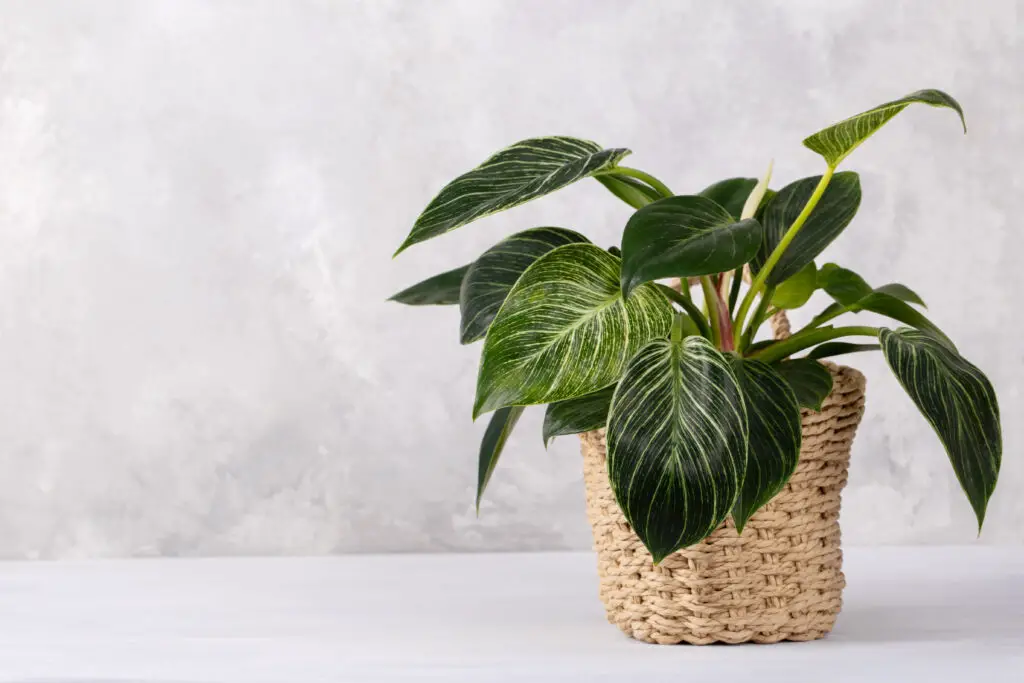
How do you treat leaf spot disease in Philodendron?
Leaf spot disease is a common problem in Philodendron plants. To treat it, first, remove the affected leaves and dispose of them properly. Then, apply a fungicide to the remaining leaves to prevent the disease from spreading.
Make sure to follow the instructions on the fungicide label carefully. Additionally, avoid overwatering and ensure proper ventilation to prevent the disease from recurring.
Why are my Philodendron leaves turning yellow with brown spots?
Yellow leaves with brown spots on Philodendron plants can be caused by several factors, including overwatering, low humidity levels, and nutrient deficiencies.
To address this issue, check the soil moisture level and adjust watering accordingly. Increase humidity levels by placing a humidifier near the plant or placing a tray of water near it. Fertilize the plant with a balanced fertilizer to ensure proper nutrient levels.
What causes brown spots on philodendron leaves?
Brown spots on Philodendron leaves can be caused by various factors, including bacterial and fungal infections, pests, and environmental stress.
To identify the cause, inspect the plant closely and look for signs of pests or infections. Address the underlying cause by removing infected leaves, applying appropriate pesticides, and ensuring proper environmental conditions.
What are the burn spots on my Philodendron?
Burn spots on Philodendron leaves can be caused by exposure to direct sunlight or chemical burn from fertilizers or pesticides. To prevent sunburn, move the plant to a location with indirect sunlight.
Avoid using high-concentration fertilizers or pesticides, and always follow the instructions on the label carefully.
How do you prevent bacterial leaf spot in Philodendron?
Bacterial leaf spot in Philodendron can be prevented by avoiding overhead watering, providing proper ventilation, and avoiding overcrowding.
Additionally, ensure that the plant is not exposed to extreme temperature fluctuations. If the disease does occur, remove infected leaves and apply a copper fungicide to prevent the disease from spreading.
What is the best way to care for Philodendron with yellow spots on leaves?
To care for Philodendron with yellow spots on leaves, ensure proper watering and humidity levels, provide adequate light, and fertilize the plant regularly.
Remove infected leaves and apply appropriate treatments to address any underlying issues. Monitor the plant closely and adjust care as needed to ensure healthy growth.

Hey, I’m Lisa and I’ve been an avid gardener for over 30 years. I love writing, talking and living in the garden! Feel free to connect with me on my socials below

